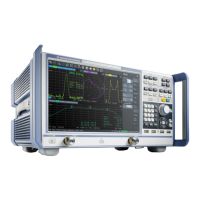Concepts and Features
R&S
®
ZNB/ZNBT
84User Manual 1173.9163.02 ─ 55
Use the "Alternated" mode to increase the accuracy of measurements on DUTs with
long level settling times (e.g. quartzes, SAW filters). To measure DUTs with short set-
tling times and obtain a trace from the beginning of the sweep, use "Chopped" mode.
In "Auto" mode, the analyzer optimizes the display update: Fast sweeps are performed
in "Alternated" mode, slower sweeps in "Chopped" mode.
As an alternative to activating the "Alternated" mode, it is possible to insert a measure-
ment delay before each partial measurement and thus improve the accuracy.
See CHANNEL – [SWEEP] > "Sweep Params" > "Meas Delay".
However, the delay slows down the measurement.
Relation to trigger settings
In triggered measurements, "Alternated" has no effect if the triggered measurement
sequence is identical to a single sweep point. The following table shows how the ana-
lyzer performs a sweep comprising m sweep points, assuming that each of them
requires n partial measurements.
Triggered Meas.
Sequence
Alternate On Alternate Off
Sweep Trigger event starts n partial sweeps over
all sweep points.
Trigger event starts m complete
measurements at consecutive sweep
points.
Sweep Segment Trigger event starts n partial sweeps over
the next segment.
Trigger event starts complete mea-
surements at all consecutive sweep
points in the segment.
Point All partial measurements of each sweep
point are carried out one after another.
All partial measurements of each
sweep point are carried out one after
another.
Partial Measurement Each partial measurement is carried out
for all sweep points.
All partial measurements of each
sweep point are carried out one after
another
5.1.4.2 Parallel Measurements on Multiple DUTs
The support for parallel measurements on multiple DUTs depends on the analyzer
type:
●
For a 2-port R&S ZNB or a 4-port R&S ZNB without internal second source (see
Chapter 5.7.13, "Internal Second Source", on page 232) this feature is not availa-
ble
●
For a 4-port R&S ZNB with Internal Second Source, VNA ports 1 and 2 can mea-
sure one DUT, while port 3 and port 4 can measure another one (using the same
stimulus settings).
●
Each internal generator of a R&S ZNBT can drive multiple VNA ports simultane-
ously. Because of this, even without Internal Second Source either multiple paths
of a single DUT or multiple DUTs can be measured in parallel (using the same
stimulus settings).
Basic Concepts

